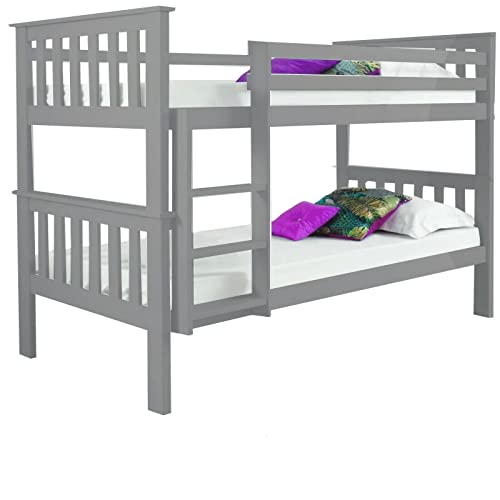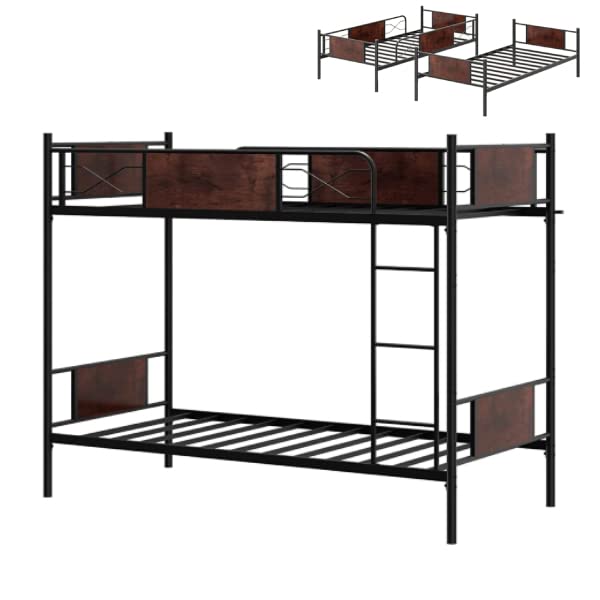5 Must-Know-How-To Bunk Bed And Single Bed Methods To 2024
Page Information

Content
 Choosing Between a Bunk Bed and single bunk bed with mattress Bed
Choosing Between a Bunk Bed and single bunk bed with mattress BedWhen deciding on bunk bed or single beds, you need to think about the mattress size choices. Twin size mattresses are ideal for smaller children or adult single bunk bed desk sleepers. They are best suited to rooms that measure 7 feet by 10 inches.
 Families with children of various ages will benefit from a twin over full bunk. Another option that is popular is the futon bunk that includes a lower futon that transforms into a bed.
Families with children of various ages will benefit from a twin over full bunk. Another option that is popular is the futon bunk that includes a lower futon that transforms into a bed.Space Saving
Bunk beds are an ideal option for families who want to maximize their living space. This kind of furniture allows families to have two beds in the same space without wasting valuable floor space that could be used for other furnishings like dressers and desks.
Bunked beds are a common choice for kids' rooms due to the fact that they can provide more study and play spaces while also allowing for more space in smaller living spaces. They are, however, an excellent choice for adults as well and offer a stylish alternative to conventional single bed frames. The most sophisticated bunkbed owners can incorporate accessories and decorations that can enhance their bed and make their beds feel more like a home.
The primary benefit of Wooden bunk Beds single beds is that they allow children to share rooms and sleep in the same room with one bed bunk bed another. This arrangement can lessen conflict within the home by allowing children to share rooms. It can also increase the amount of storage space available in a child's room by eliminating the need for dressers and other furniture pieces that are large.
There are many different types of bunk beds, however they all share the same designs to maximize space. Standard bunk beds have two mattresses of the same size on top of each other. A twin over full bed can also be set up in the same way with two beds of full size on the bottom and a twin mattress on top. A futon bunk is a combination of a standard bunk and an American-style futon couch which converts to an ottoman. It is an excellent option for families who want traditional, space-saving bunks.
Although bunk beds are a less expensive alternative to single beds, they could require more frequent repairs and maintenance because of their multi-tier structure. Bunk beds can also be less accessible to those with mobility problems or those at risk of falling than single beds. When choosing bedding for their facility healthcare facilities must balance the initial cost with the long-term benefits.
single bunk bed mattresses beds are less costly to maintain than bunk beds, and their simple design makes them easier to clean and repair. They can also be moved to meet the needs of patients or accommodate changes to room layouts. This flexibility is particularly beneficial for healthcare facilities which must be able to accommodate a wide range of patient demographics.
Convenience
Bunk beds are an excellent solution for families that have children who differ in age. Similar to a twin over full bunk configuration is ideal for siblings with different sleeping preferences. For instance, younger children may prefer to be closer to dad and mom, while older kids may enjoy sleeping on their own.
Bunk beds also save money because they decrease the number of mattresses that have to be purchased. Some bunk beds come with built-in storage, which eliminates the need for separate dressers. This can help reduce the clutter in rooms for patients and make the most space.
Another benefit of bunk beds is their ability to assist facilities in increasing the capacity of beds. They are ideal for cramped rooms, such as rehabilitation centers and youth psychiatric units where patients typically share rooms. They can be placed in long-term care facilities to accommodate large groups.
Although bunk beds come with many advantages, they can be more difficult to clean and maintain than a single bed. The additional stress on joints and frames can result in increased wear and tear, requiring more frequent maintenance and inspections. The design of the bunk bed could create problems for those with mobility issues or specific health conditions. Climbing up and down can be dangerous, especially for seniors.
Single beds can be rearranged to accommodate different layouts in rooms and provide patients with a more personalized experience. Journal of Environmental Psychology states that this flexibility can increase the satisfaction of patients by 25 percent.
Consider your patient demographics, your space constraints, and your maintenance requirements when choosing the ideal bed for your facility. Bunk beds can be an ideal option for facilities that want to save space or require less setup time. Single beds are a good choice for rooms with a high turnover or limited budgets.
When considering a bunk bed, make certain to select a model that has a clean mattress. The best mattresses for bunk beds are latex, innerspring, memory foam or hybrid. However, some individuals prefer futon. Verify that the mattress in the bunk bed is upholstered or slatted. A slatted bunk bed has the base of slats or slat rolls, that are hammered or screwed together to support the mattress.
Safety
Bed safety is a key aspect when it comes to furnishing health facilities. Bunk beds can create an environment that is safe, by maximising space and minimizing risks. They also have the advantage of reducing injuries due to a lower center of gravity, which is advantageous for elderly and physically disabled people.
The most important factor in bunk bed safety is a proper assembly and regular maintenance. Examine for unstable or loose pieces and reinforce any weak points to prevent structural failure. Adhere to manufacturer-recommended weight limits, as excess loading can compromise stability. Also make sure that ladders are properly attached to the frame and are constructed from sturdy materials to avoid falling or the possibility of entrapment.
After proving that they are able to safely climb up and down is it appropriate for children to sleep in the top bunk. They should be able to take care of their personal hygiene on their own without supervision or assistance, including using the bathroom and dressing themselves. In addition, bunk beds must be positioned far enough away from windows to limit the risk of injuries resulting from windows.
Bunk beds have a disadvantage in that they're not great at separating noise and motion which can be a nuisance to sleepers who are light. The sleepers in the bottom bunk might be able to hear or feel their counterparts moving around in their bed.
Single beds, however, offer better sound and movement isolation. Moreover, they offer the ability to accommodate a range of demographics for patients and rooms sizes.
The choice between bunk beds and single beds is contingent on the facility's needs and budget. A bunk bed is a budget-friendly option for healthcare facilities with small space and a high patient turnover rate, while single beds are ideal for long-term care units and rehabilitation centers with consistent populations. It is important to weigh the initial cost against the long-term benefits and put the emphasis on the comfort of the patient and security. All beds require regular inspections as well as timely upkeep, irrespective of their kind. According to the Facilities Management Journal, a proactive approach to maintenance can cut down on repair costs by up to 15%..
Functionality
Apart from the obvious benefits of space-saving Bunk beds can also help to create a sense between siblings or friends sharing the same space. They are perfect for families with children of different ages or for multiple children who want to share a room, and they can also work well in rehabilitation facilities or in youth psychiatric units where patients need to be able to sleep in a crowded setting.
Bunk beds are available in various configurations and some even include storage space. Twin over full bunks, which are very popular have a twin mattress at the bottom and a double mattress on top. This is ideal for families with children of various age or adults who wish to share a large bed with a partner or a friend. L-shaped bunks can be a stylish alternative to the traditional bunk layout. The lower part of the unit functions as an ottoman that can be used as a couch, or adjusted to become double beds.
Bunk beds are more space-efficient, but they require more maintenance due to their multi-tiered design. This can include frequent repairs and regular inspections to ensure safety, as outlined by the Facilities Management Journal. Single beds, on the other hand are more manageable and require less frequent attention, which makes them a cost-effective choice for long-term use.
Another thing to consider when picking bunk beds is that they tend to offer less privacy than single beds, as guests share their space with another. This can be difficult for some people, especially in shared accommodations like rehabilitation centers or transitional housing.
Single beds and bunk beds are both customizable with extra features such as desks and storage for a an environment that is more functional for sleeping. This is particularly useful in smaller spaces that require to make the most of their space. They can help to eliminate clutter, and free up space on the floor to accommodate furniture or other activities. Some bunk beds small single beds are even divided into two beds. This lets them expand with the child, and also provide comfort as they enter adulthood.
- PreviousBunk Bed And Single Bed Tools To Streamline Your Daily Life Bunk Bed And Single Bed Trick That Should Be Used By Everyone Be Able To 24.10.24
- NextThe Reason Why Bunk Bed And Single Bed Is The Most-Wanted Item In 2024 24.10.24
Comment list
There are no registered comments.
